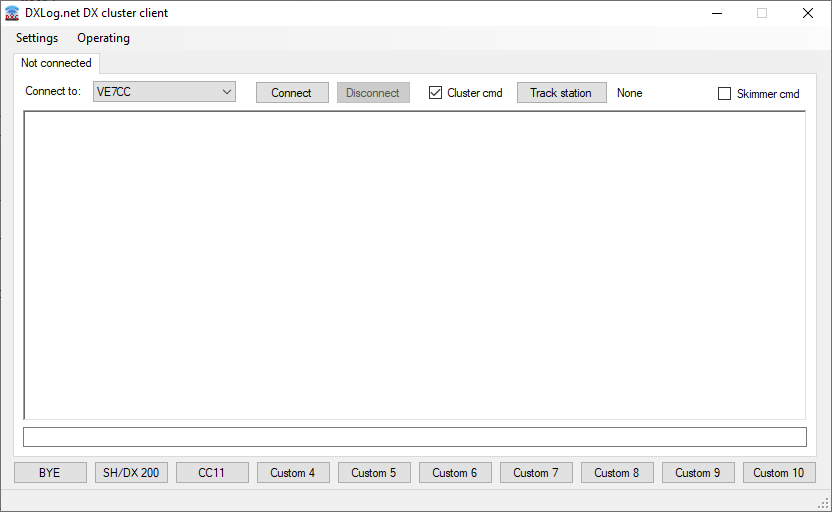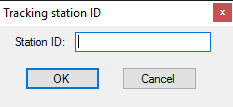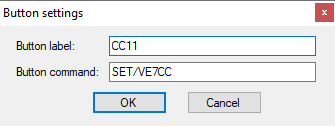Difference between revisions of "DXLog.net.DXC"
(→Setup) |
(→Operation) |
||
| Line 40: | Line 40: | ||
==Operation== | ==Operation== | ||
| − | Once set up you can now connect to your favorite cluster servers from the dropdown list, select and click connect. | + | Once set up you can now connect to your favorite cluster servers from the dropdown list, select and click connect.<br> |
| − | If you want to add or amend this list, this must be done from within | + | If you want to add or amend this list, this must be done from within DXLog.net. [http://dxlog.net/docs/index.php/Menu_Options#DX_cluster] |
| − | You can add another cluster server connection with | + | You can add another cluster server connection with Settings->New tab. This will create a new tab and the connection process is the same. |
| − | If you want networked stations | + | If you want allow networked stations to send commands to the connected cluster then check the "Cluster CMD" box for that particular connection. |
| + | |||
| + | To control a local CW skimmer DXLog.netDXC can send automatic QSY commands.<br> | ||
| + | If you want to use this feature, decide which DXLog.net station you want CW Skimmer to track,<br> | ||
| + | click on "Track station" on the local skimmers tab and enter its station ID into the box and press enter.<br> | ||
| + | Also check the "Skimmer cmd" check box on the local skimmer tab. | ||
| − | |||
| − | |||
[[image:trackid.png]] | [[image:trackid.png]] | ||
| − | |||
| − | If you have multiple tabs and want to connect to all the servers, | + | Once complete, try a band change on the radio connected to that station. <br> |
| + | You should see the QSY command sent and the CW Skimmer QSY. | ||
| + | |||
| + | If you have multiple tabs and want to connect to all the servers,<br> | ||
| + | click Operating->Connect all. This will issue connect commands on all tabs | ||
| + | |||
[[image:connectall.png]] | [[image:connectall.png]] | ||
| − | |||
| − | You have the option of | + | Now if you open DXcluster monitor on all LAN network connected DXLog.net you should<br> |
| − | To set, right click on a button, | + | see the data from DXlog.net.DXC propagating through. |
| + | |||
| + | You have the option of defining up 10 buttons which are at the bottom of the DXlog.net.DXC window.<br> | ||
| + | These allow you to send cluster commands with a single click.<br> | ||
| + | To set, right click on a button, enter the name and the command you would the button to send and then click OK. | ||
| + | |||
| + | To secure connectivity and to automatically reconnect lost links, DXLog.net.DXC contains a watchdog with a time-out of 60 seconds.<br> | ||
| + | If no traffic has been received within this time period, DXLog.net.DXC will issue an empty command which should make the<br> | ||
| + | cluster node respond with a prompt. If there is no response for 10 seconds, a reconnect operation will start.<br> | ||
| + | |||
| + | This means that you may see prompts appearing "randomly" in the data flow from low activity cluster nodes.<br> | ||
| + | Some telnet servers, like CW Skimmer Server and RBN Aggregator, does not accept empty commands and will issue a (harmless) error. | ||
| + | |||
[[image:clusbuttons.png]] | [[image:clusbuttons.png]] | ||
Revision as of 21:12, 6 November 2019
Program
DXLog.net.DXC is a multi connection DX Cluster client for DXL, it can handle multiple WAN connections to various DX Cluster Servers as well as local CW Skimmers. The program can be run stand alone on any PC on the network and its data is sent via UDP packets to all network connected DXLog.net on the LAN.
DXC has the ability to automatically track a CAT controlled radio connected to one instance of DXLog,net on the LAN, this allows auto QSY of the local skimmer, provided the radio connected to the CW skimmer supports this.
To start click on the DXlog.net.DXC icon on the desktop of from the start menu
Setup
When the program is first started you must set up the callsign you will use to connect to the cluster servers. Click on settings and user data
Fill in your callsign and click OK Next you must set up the network so DXlog.net.DXC knows where to broadcast out the received cluster data. Click on settings and Network
If your using on the same computer as DXL then broadcast IP 127.255.255.255 will only broadcast the data to this PC and DXL on this computer. If you are using multiple computers or a stand alone then the broadcast IP must be the same as that in DXL's network settings ie 192.168.0.255 The broadcast UDP port setting must be set the same as that in DXL usually 9888 The station ID can be anything you want but should not be the same as any other DXL on the network Once set up click OK If you are running a local skimmer then next you should set up the Skimmer Bandwidth to replicate that as set in CW Skimmer
If you want CW skimmer to track a radio on one of the networked DXL's, set up the tracking type
Fixed on bandwidth/2 uses the set skimmer bandwidth divided by 2 to give the center freq, so 96hkz/2 = 48 .. so on 40m the skimmer would be set to 7.048 Same as tracking station follows the selected network connected radio's VFO Dynamically calculated keeps a fixed frequency of bandwidth/2 until the connected radio's VFO is tuned above 3/4 of the bandwidth, it will then QSY up 25khz, if the radio is tuned back down, the skimmer will QSY back down.
Operation
Once set up you can now connect to your favorite cluster servers from the dropdown list, select and click connect.
If you want to add or amend this list, this must be done from within DXLog.net. [1]
You can add another cluster server connection with Settings->New tab. This will create a new tab and the connection process is the same.
If you want allow networked stations to send commands to the connected cluster then check the "Cluster CMD" box for that particular connection.
To control a local CW skimmer DXLog.netDXC can send automatic QSY commands.
If you want to use this feature, decide which DXLog.net station you want CW Skimmer to track,
click on "Track station" on the local skimmers tab and enter its station ID into the box and press enter.
Also check the "Skimmer cmd" check box on the local skimmer tab.
Once complete, try a band change on the radio connected to that station.
You should see the QSY command sent and the CW Skimmer QSY.
If you have multiple tabs and want to connect to all the servers,
click Operating->Connect all. This will issue connect commands on all tabs
Now if you open DXcluster monitor on all LAN network connected DXLog.net you should
see the data from DXlog.net.DXC propagating through.
You have the option of defining up 10 buttons which are at the bottom of the DXlog.net.DXC window.
These allow you to send cluster commands with a single click.
To set, right click on a button, enter the name and the command you would the button to send and then click OK.
To secure connectivity and to automatically reconnect lost links, DXLog.net.DXC contains a watchdog with a time-out of 60 seconds.
If no traffic has been received within this time period, DXLog.net.DXC will issue an empty command which should make the
cluster node respond with a prompt. If there is no response for 10 seconds, a reconnect operation will start.
This means that you may see prompts appearing "randomly" in the data flow from low activity cluster nodes.
Some telnet servers, like CW Skimmer Server and RBN Aggregator, does not accept empty commands and will issue a (harmless) error.




